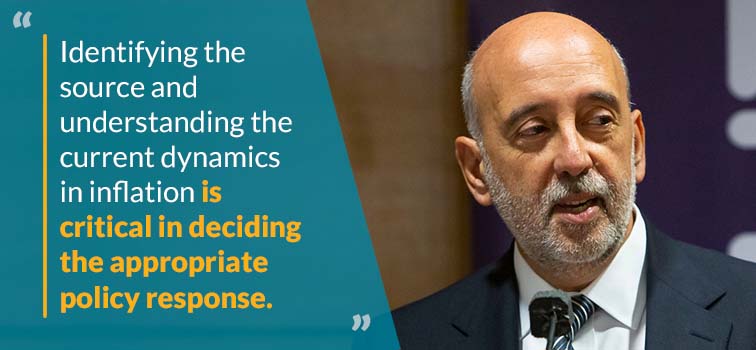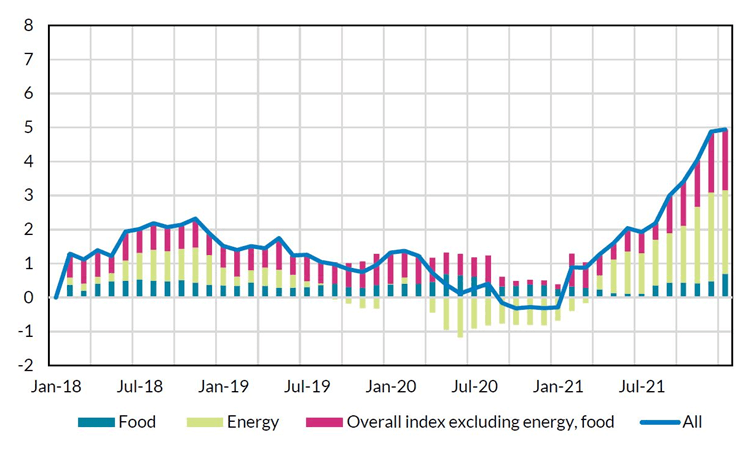Inflation in the euro area and Ireland
10 February 2022
Blog

Last week I attended this years first monetary policy meeting of the ECB's Governing Council. The economic outlook is positive. Economies are proving resilient to the pandemic, as each successive wave of the virus appears to be having a reduced economic impact.
The current drivers of inflation
Inflation, however, is currently high, with the latest flash estimate for January of 5.1% released last week. It has been increasing since last year due to a variety of factors (which I have discussed previously), including higher energy prices, a recovery in prices for some goods and services that fell sharply during the pandemic, and a rebound in demand which is meeting global supply bottlenecks in both inputs and transportation.
Energy prices remain the main driver. More than half of the recent increases in headline inflation come from energy price rises (see Figure 1) which have both a direct and indirect effect on the cost of goods and services. The direct effects on home heating or electricity and personal transport fuels – driven in particular by changes in international energy markets – tend to pass through quickly to consumers. Indirect effects occur via the impact on business costs and tend to be passed on more slowly and only partially to consumers.
Figure 1: Euro area headline inflation and subcomponents
(annual percentage changes)
 Source: Eurostat
Source: Eurostat
In deciding how to respond to inflation developments, monetary policy makers need to consider two things. First, what is the source of the inflation? And, second, what is the potential for more persistent inflation above our 2 per cent target in the medium term?
Identifying the source and understanding the current dynamics in inflation is critical in deciding the appropriate policy response. Strong increases in energy prices mean that the leading driver of current inflation has been from the supply side but monetary policy’s primary effect is through the demand side of the economy. As I said in November, constraining demand to bring it back into line with what might be a temporary supply interruption could depress incentives for supply to return and therefore be counterproductive.
But we have also seen evidence of more broad-based price changes, beyond just energy prices. "Core" inflation in the euro area (that is, excluding food and energy) was 2.3% in January, up from 1.6% six months previously. Some of this reflects the slow pass-through of the indirect energy price increases I mentioned above, as well as other global supply bottlenecks. While our current expectation is for both headline and core inflation to fall over the current projection horizon (to end-2024), we pay close attention to developments in core inflation to help us form a view on inflation dynamics over the medium term.
I also see developments in the labour market as central to our deliberations, in two respects. First, we need to track the extent to which cost of living pressures are reflected in wage demands, and in turn put more upward pressure on firms; costs and prices. And, second, the record low euro area unemployment of 7% in December (and projected to fall even further as job openings rise), this could also put upward pressure on wages and ultimately prices, as reflected in our December projection. Although wage growth in the United States has been robust in recent months (and inflation drivers there are not the same as those in Europe), we have yet to see strong evidence of this in
the euro area (notwithstanding that our wage data comes with a long lag). Overall, I think it is fair to say that the risks to inflation- from many sources- are to the upside in the near term.
With the cost of living rising, and people having to spend an increasingly large share of their income on energy in particular, it can leave less money to spend on other goods and services. As President Lagarde outlined last week, there is unanimous concern among members of the Governing Council at the impact of high inflation on citizens across the continent, particularly those who "are most vulnerable, most exposed and who face the day-to-day hardship of having to put up with higher prices".
The varying experience of inflation for different groups is something I have discussed previously in an Irish context. Not everyone in the community will experience price increases in the same way and some people will be more (or less) impacted by the recent bout of inflation, simply because they are more or less exposed to certain price changes.
With recent inflation driven by energy prices, lower income households in Ireland, older people, and rural households have been more affected. This is because a larger proportion of their spending, compared to other groups, is spent on energy (Figure 2). Conversely, higher income households, younger people and more urban households tend to spend more on services.
Monetary policy is a lever that impacts aggregate demand. It is not an effective tool to deal with supply side drivers, or to address the distributional effects of inflation. If current trends in overall inflation persist, the case for monetary policy action becomes stronger. But we need to be conscious of the effects of tightening policy: constraining demand now to bring it back into line with supply would impact on inflation with a lag but there would be a more immediate trade-off in terms of growth and employment.
Figure 2: Inflation effects for different groups (Irish Households, December 2021 HICP)
(Annual percentage changes)
.png?sfvrsn=44db931d_2)
*Working age households only (i.e. 16-64 years of age)
Source: Central Bank of Ireland Calculations
Conclusion
The inflation outlook, as always, will be of key concern for the members of the Governing Council in the coming months. We need to be forward-looking in our analysis and assessment, while recognising and monitoring the extent of current uncertainties. These uncertainties are accumulating, including some unforeseen events towards the end of last year. Some will have a shorter-term impact on inflation, whereas others could prove to be more long-lasting. It will be important to remain data-driven in our assessment of the evolving inflation outlook and ready to take policy actions to ensure that inflation stabilises at our two per cent target over the medium term.
Gabriel Makhlouf
Read more: